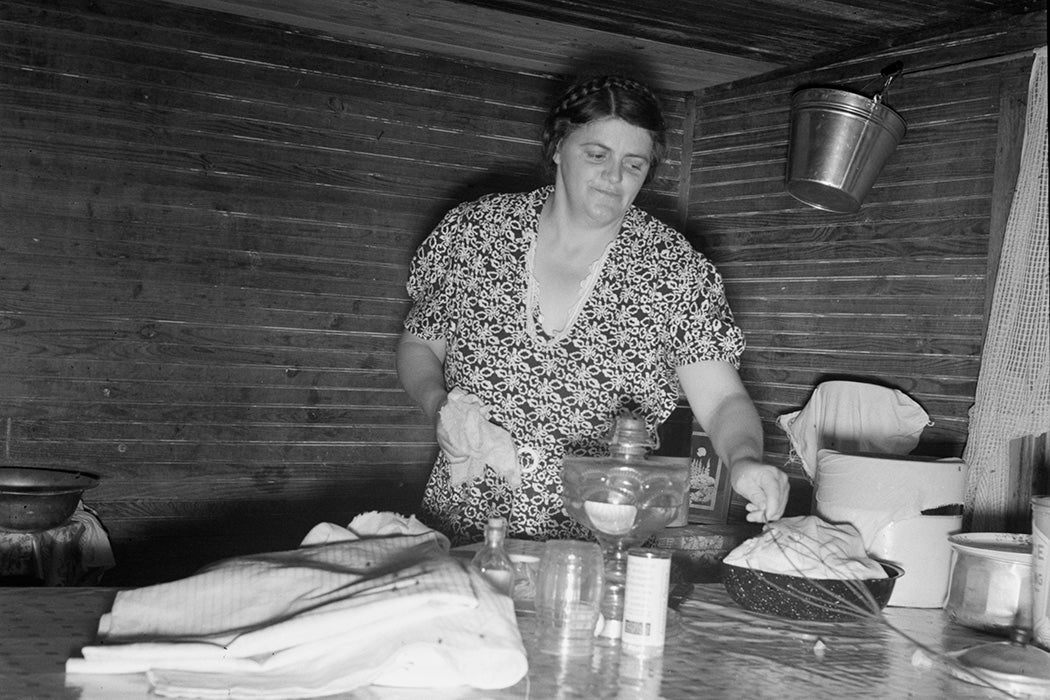In recent years, shows, documentaries, and cookbooks have drawn attention to regional foodways in the United States, including the traditions and innovations of the South. As American studies scholar Marcie Cohen Ferris writes, deeply researched appreciations of southern food go all the way back to the New Deal.
In the 1920s and ’30s, Ferris writes, Americans tended to view the food of the South in polarized ways. Advocates for preserving “southern heritage” praised the bountiful tables of rural white southerners while minimizing the history of slavery and the continuing role of Black cooks in white households. Others focused on the deficient diet of Black and white sharecroppers and tenant farmers, which relied heavily on salt fat pork, cornbread, and molasses.
To develop a more nuanced understanding of southern food cultures, writers and photographers hired under New Deal programs collaborated with academics.
In 1939, the Farm Security Administration (FSA) photodocumentary project sent Dorothea Lange to North Carolina. Lange had taken her famous “Migrant Mother” photograph for the agency in California three years earlier. She and fellow photographer Marion Post Wolcott worked with sociologists Margaret Jarman Hagood and Harriet Herring from Chapel Hill, experimenting with photography as a social-research tool. Hagood’s writing contrasted popular images of overflowing southern tables with the reality of white tenant farmers, who often subsisted on cabbage, sweet potatoes, and field peas.
Ferris writes that Lange and Wolcott captured images of farmwives making biscuits, Black tenant farmers feeding chickens, farmers selling tobacco at loose-leaf auctions, and university students eating at Harry’s Delicatessen in Chapel Hill. At one all-day corn-shucking, Hagood described the racial and gender hierarchies embedded in a meal:
The food was prepared by the wife and her four sisters-in-law and one Negro woman… Two tables were put together in the dining room. All the white men ate first, then the table was cleared and the dishes washed and the table re-set for the white women and children. After they ate the dishes were washed and the table reset again for the Negro men.
Meanwhile, the Federal Writers’ Project (FWP) hired documentarians with ties to Franz Boas and the new American schools of anthropology and folklore. The FSA and FWP employed emerging southern writers, including Margaret Walker, Eudora Welty, Richard Wright, and Zora Neale Hurston.
Weekly Newsletter
Ferris writes that the FWP’s American Guide Series, with books on each state and territory, romanticized both the plantation tradition and Black cooks. But it also presented southern food traditions seriously, offering recipes for New Orleans specials like “Galatoire’s Trout Marguery” and descriptions of traditions like North Carolina breakfasts of broiled salt roe herring and biscuits. For Florida’s guidebook, Hurston described the African American imaginary land Diddy-Wah-Diddy, where baked chickens and sweet potato pies wander the streets, inviting travelers to eat as much as they want.
Like that story, the work of the writers, photographers, and scholars illustrated culinary creativity in the face of the material hardship many southerners faced in the 1930s.
Support JSTOR Daily! Join our new membership program on Patreon today.







